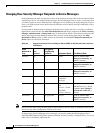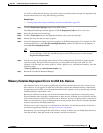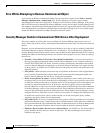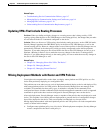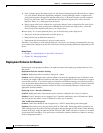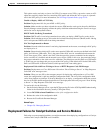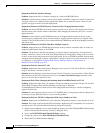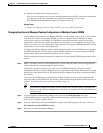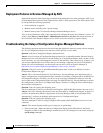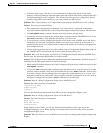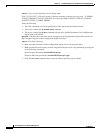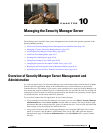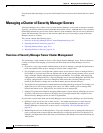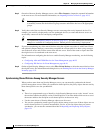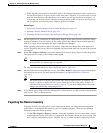
9-18
User Guide for Cisco Security Manager 4.4
OL-28826-01
Chapter 9 Troubleshooting Device Communication and Deployment
Troubleshooting Deployment
Deployment Failures to Devices Managed by AUS
Deployment might fail when deploying to multiple AUS-managed devices after starting the AUS if you
perform deployment before the Auto Update Server (AUS) is fully operational. The AUS requires time
to start up after the following operations:
• New installation or upgrade.
• Manual restart (including after a power outage).
• Manual restart of the Cisco Security Manager Daemon Manager service.
You can verify whether the AUS is fully operational by verifying the status of its Windows services. To
do this, select Start > Control Panel > Administrative Services > Services, then check the status of
the CiscoWorks AUS Database Engine service. If this service has started, try again to deploy.
Troubleshooting the Setup of Configuration Engine-Managed Devices
The following questions and answers describe issues that might arise when you set up a device managed
by a Cisco Configuration Engine (also known as CNS) and how to solve them:
Question: Why does Configuration Engine deployment fail?
Answer: Not all versions of Configuration Engine function in a compatible manner. Because Security
Manager does not verify the software version running on a Configuration Engine when you add it to the
device inventory, you can add unsupported versions to the inventory. Then, when you try to deploy, you
can run into unpredictable errors. Ensure that you are running a supported version of Configuration
Engine (for version information, see the release notes for this version of Security Manager at
http://www.cisco.com/en/US/products/ps6498/prod_release_notes_list.html).
Question: Why do I receive an InvalidParameterException when I click on an IOS device on the
Configuration Engine web page?
Answer: This is the expected behavior. For IOS devices, Security Manager uses deployment jobs to
deploy configurations to Configuration Engine instead of associating a configuration to the IOS device
in Configuration Engine. Therefore, you do not see an associated configuration when you click the
device name on the Configuration Engine web page. For ASA/PIX devices, Security Manager associates
the configuration to the device in Configuration Engine. Therefore, clicking the device name displays
the associated configuration.
Question: Why am I getting the following error:
com.cisco.netmgmt.ce.websvc.exec.ExecServiceException: [002-01003]]deviceName does not exists?
Answer: This error indicates that the device has not been added to Configuration Engine. It appears if
you have not performed rollback or deployment in Security Manager (both of which add the device
automatically), and have not manually added the device to Configuration Engine.
Question: Why am I getting the following error:
com.cisco.netmgmt.ce.websvc.config.ConfigServiceException: [002-01003]]Device device id is not
connected
Answer: The answer depends on the type of setup you are performing:
• Event mode setup—Make sure that the Configuration Engine device ID defined in the Device
Properties window in Security Manager matches the device ID configured on the router (using the
cns id string command).



